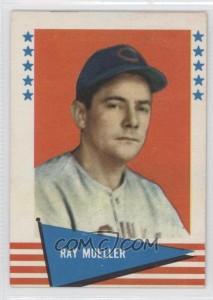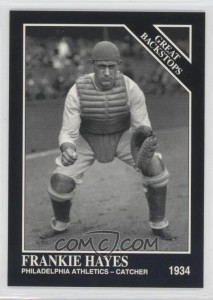
 Seventy years ago, wartime necessity redefined the possible for big-league catching. That year, two catchers, Ray Mueller in the NL and Frankie Hayes in the AL, achieved a feat unmatched by any player before or since – starting as catcher in EVERY game of the season.
Seventy years ago, wartime necessity redefined the possible for big-league catching. That year, two catchers, Ray Mueller in the NL and Frankie Hayes in the AL, achieved a feat unmatched by any player before or since – starting as catcher in EVERY game of the season.
After the jump, more on these two players and the change in catcher usage that they pioneered.
The table below shows the number of players appearing as catcher in 90+ games for seasons before, during and after World War II.
| Year ▴ | #Matching |
|---|---|
| 1938 | 12 |
| 1939 | 10 |
| 1940 | 15 |
| 1941 | 16 |
| 1942 | 10 |
| 1943 | 10 |
| 1944 | 10 |
| 1945 | 8 |
| 1946 | 8 |
| 1947 | 14 |
| 1948 | 13 |
| 1949 | 12 |
From just about every team having a primary full-time catcher before the war, that number was quickly chopped in half before returning to close to pre-war levels after war’s end. And, catchers at the 120 game level, scarce before the war, all but disappeared.
| Year ▴ | #Matching | |
|---|---|---|
| 1938 | 4 | Bill Dickey / Rick Ferrell / Ernie Lombardi / Al Todd |
| 1939 | 5 | Harry Danning / Bill Dickey / Ernie Lombardi / Al Lopez / Mickey Owen |
| 1940 | 4 | Harry Danning / Frankie Hayes / Bob Swift / Mike Tresh |
| 1941 | 3 | Ray Berres / Frankie Hayes / Mickey Owen |
| 1942 | 1 | Mickey Owen |
| 1943 | 2 | Jake Early / Ray Mueller |
| 1944 | 3 | Frankie Hayes / Ray Mueller / Mickey Owen |
| 1945 | 2 | Frankie Hayes / Mike Tresh |
| 1946 | 1 | Phil Masi |
| 1947 | 4 | Walker Cooper / Bruce Edwards / Jim Hegan / Phil Masi |
| 1948 | 4 | Jim Hegan / Ray Lamanno / Andy Seminick / Birdie Tebbetts |
| 1949 | 2 | Roy Campanella / Jim Hegan |
The fact that, even before the war, so few catchers played even 120 games was not unusual. From 1901 to 1941, only 48 catchers had had such a season, including just 29 who had done so more than once, and only 17 with more than two such seasons. From 1914 to 1941, there were only 15 seasons of catching 120 complete games, with only Ray Schalk, Harry Danning and Hank Severeid doing so more than once. George Gibson was the pre-war workhorse champion with 143+ games caught in 3 consecutive seasons (1908-1910), including 150 games in 1909, missing just four of the world champion Pirates’ contests (after 108 years as the career leader in games played for Canadian-born catchers, Gibson seems destined to be passed by Russell Martin sometime in the 2015 season).
That sets the scene for the Reds and Athletics as 1944 dawned. Ray Mueller entered that year having played the final 33 games of the 1943 season. Whether it was unavailability of an alternate catcher or some other reason, there was a definite change from July to August of that season with Mueller getting 7 days off in July, each time during the second game of a double-header. No such mercy in August as Mueller started both ends of 6 of the 7 double-headers that month, completing the game or lasting until the 9th inning or later in 11 of those 13 contests.
It was a different story for Frankie Hayes who had split catching duties with Rick Ferrell on the Browns’ teams of 1942 and 1943, where his streak started with the final two games of the latter season. Unluckily for Hayes, a trade prior to the 1944 season denied him a spot with that year’s AL champions, instead returning him to Philadelphia and a reunion with Connie Mack’s As. Mack had already dealt away Bob Swift, his secondary catcher from 1943 and, with Hayes in harness, he did the same early in 1944 with Hal Wagner, his primary backstop from the prior season. Only third-string receiver Tony Parisse remained from the 1943 club to backup Hayes (though Mack would eventually use no fewer than 5 players to catch the handful of innings that did not go to Hayes).
Frankie Hayes started his 1944 marathon lasting at least until the 9th inning in each of the Athletics’ first 39 games, 38 of them complete games, including 6 double-headers and 7 extra-inning tilts, two of which went to 16 innings. Hayes got a breather in game 40, removed in mid-game of an 18-8 spanking by the Browns. Thirty-seven more games took Hayes to the All-Star break, again completing or lasting until the 9th inning in all but one of those contests, that being a mid-game replacement in an 8-0 whitewash by the Tigers. Included in this stretch were 11 double-headers (including 3 in 4 days) and 5 more extra-inning games. Rejuvenated by a 4-day break, Hayes’ next 33 games included just 6 double-headers (but 3 in a 5-day span). Hayes completed or lasted until the 9th inning or later in 31 of those games, and had 3 PA in each of those other 2 contests. The final 45 game stretch featured 10 more double-headers (another 3 in 5-day set) during which Hayes got a bit more of a break, getting removed in the early or middle innings 6 times. After CGs in both ends of a season-ending double-header, it was 155 games for the Athletics (including one tie game) and 155 games as the starting catcher for Frankie Hayes, including 135 complete games.
Mueller’s odyssey followed a similar course to Hayes except that most of Mueller’s “rest” came early in the season, completing only 5 of his first 10 games and 15 of his first 25. But, from July 16th to September 16th, Mueller completed 55 of 58 games, logging complete games in both ends of 12 double-headers. The next day, with the Reds playing their fourth double-header in 5 days, Mueller got a break after the Pirates took a 7-0 lead after 6 innings of the first game. Mueller would catch every inning the rest of the way until a 5th inning replacement in the season finale. Season totals: 155 Reds games (including one tie game), 155 games as starting catcher for Mueller, including 140 complete games.
Those complete game totals are for defensive games, so they are slightly different from running a complete game query using P-I’s game finder (for example, being removed for a pinch-hitter or pinch-runner in the top of the 9th inning when the home team doesn’t bat in the bottom of the inning would count as a defensive complete game, but *not* as a complete game in P-I). Thus, P-I says that Hayes and Mueller “completed” only 132 and 131 games, then the 3rd and 4th highest searchable totals, behind the 136 complete games for Ray Schalk (1920) and Muddy Ruel (1924). Regardless, the 155 games started at catcher for Hayes and Mueller were then the most ever and today trail only Randy Hundley‘s 156 starts in 1968.
But the story didn’t end there. Hayes did it all over again in 1945, despite being traded in mid-season. Hayes was removed from the As May 29th home game against Cleveland after Mack dealt him to the Indians. Being able to just cross the field to the opposing dugout, Hayes traveled with his new team that night and suited up the next day for their game in Boston. When Hayes was traded, Cleveland had played four fewer games than the As. But, despite starting every game the rest of the way, Hayes ended up with only 151 games for the season as the Indians inexplicably had 9 postponed or tied games that were not made up. Hayes’ streak finally ended in the first week of the 1946 season at 312 consecutive games caught, including 293 as the starter, still the major league records.
Mueller was called to active military duty and missed the entire 1945 season. So, his 188 game streak was still active starting the 1946 season. Like Hayes, Mueller’s streak ended fairly early that season, after 16 games, for a total of 204 consecutive games caught, including 179 consecutive starts, still the NL records. He apparently suffered some sort of injury, appearing in only 10 of the Reds’ next 42 games, but finished strong with appearances in 89 of their final 97 contests.
Also notable from the 1946 season was a passing of the torch in New York with the retirement of Yankee great Bill Dickey, then the career WAR leader for catchers, and the debut of the man who would replace him. That player, of course, was Yogi Berra, who would establish new norms for catcher workload and new standards for offensive contribution. Berra would become the first player to catch 140 games in 5 seasons, and the first to catch 125 games in 7 consecutive seasons (1950-56), breaking the mark of 5 straight years by Cy Perkins (1920-24).
In offensive prowess, Berra surpassed Dickey in career WAR in the 1960 season and held top spot on that list for 17 years until surpassed by Johnny Bench, still today the career WAR leader for catchers. Berra’s power numbers also set new standards, as Berra became the first catcher to reach 250 (1957), 300 (1959) and 350 (1962) home runs.
